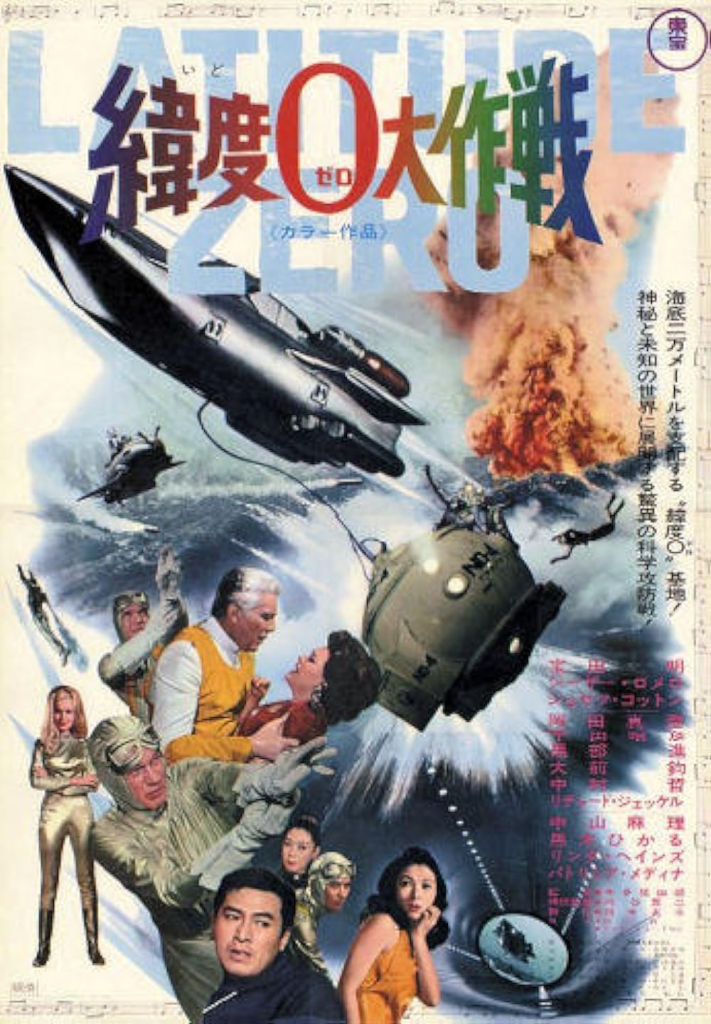
#25 in my ranking of Ishiro Honda’s filmography.
Based on a series of radio serials by Ted Sherdeman, Latitude Zero is a combination of utopian fantasy, 20,000 Leagues Under the Sea, and The Wizard of Oz. It’s kind of an odd mix. It doesn’t really work. I am surprised at how good it looks, though. The budget was cut in half right before production because the American partner to Toho, Ambassador Productions, went bankrupt. With a distinct Star Trek The Original Series vibe (no idea if there was a direct influence or more of a general 60s scifi influence), Latitude Zero has a certain flare while also being kind of dull. At least Cesar Romero is having a ball, though.
Two scientists, Dr. Ken Tashiro (Akira Takarada) and Dr. Jules Masson (Masumi Okada), are joined by a reporter, Perry Lawton (Richard Jaeckel), for a descent in a bathysphere to investigate an undersea current. They get swept away, disconnected from the ship on the surface, and end up stranded on the ocean floor where they get picked up by Captain McKenzie (Joseph Cotton) in his nuclear powered submarine, the Alpha. There’s a twist, though. Captain McKenzie represents no government. The Alpha has a plaque saying it was built in 1805. McKenzie also says that he’s 200 years old. Considering the injuries to Dr. Masson, Dr. Anne Barton (Linda Haynes), the ship’s doctor, recommends that they return to home base, the eponymous Latitude Zero, an underwater haven of scientific discovery, kind of like Galt’s Gulch (I wonder if Ayn Rand was inspired by the radio serials…?).
Now, part of the plotting that makes no sense is that McKenzie’s rival, Dr. Malic (Romero), has some kind of tracker on the Alpha that he uses to send his own submarine, the Black Shark, commanded by Kuroiga (Hikaru Kuroki). Why does the tracker suddenly start working? Well, there’s never any mention of a tracker, actually, it’s just that there’s a map that Malic has where a little light goes on and off all of a sudden that is the Alpha‘s location. There’s never talk of a traitor or mole or anything. It just kind of happens without explanation. Sure, whatever. Anyway, it does lead to the best part of the film, the extended chase between the two submarines, a special effects showcase that evolves a couple of times and works quite well.
And then we get to Latitude Zero, and it shares some of the same problems with Lost Horizon: portraits of perfect places are just not very interesting. Having McKenzie walk around, pointing at places on the large 3D map of the island with a metal pointer, and explaining how there are no bad things in this place while being dismissive of Lawton’s skepticism is just not terribly appealing. I know this portrait appeals to some people who just love to see perfect places and wish they were there, but it’s so dramatically inert that I just don’t understand the reaction.
One of the weirdest parts of the film’s structure is the central conflict between McKenzie and Malic. It’s an eternal conflict, having fought each other for a hundred years, but the direct manifestation is the kidnapping of the newest addition to McKenzie’s utopia: Dr. Okada (Tetsu Nakamura), on a ship from Japan to San Francisco. He is mentioned once in the first half, but he doesn’t actually appear until the halfway point when Malic decides to kidnap him. This is the central plot mechanic of the whole thing, the entire justification for the goings on of the third act, but it gets introduced so late. It’s weird.
Anyway, Malic does kidnap Okada and his daughter, taking them to his secret island, and McKenzie brings his new recruits along with him to rescue Okada. This is where the film’s balance between silliness and weird doesn’t really gel, and I think the problem is Joseph Cotton. Cotton takes all of what happens around him deeply seriously. In contrast is Cesar Romero who is having a ball chewing the scenery as the bad guy. The weirdness around them includes these gold-colored suits the good guys wear, the dialogue saying that they’re gold/platinum alloy which ends up being magnetic despite neither metal being magnetic, a bath that makes them impervious to bullets for twenty-four hours, and…Malic’s experiments combining creatures including punishing Kuroiga by cutting out her brain, putting it into a lion’s head, and attaching wings to make her a griffin. It’s weird how she doesn’t end up following his orders in the finale, huh?
So, it’s real silliness. It makes little sense. But a light tone (largely carried by Romero) helps a decent bit. Plus, it looks good.
I mean, this film is nonsense, but it entertains decently in the first and third acts. The strange directions of design that pretty much come out of nowhere are interesting and provide a decent guffaw. Watching Joseph Cotton take everything super seriously while dressing up very silly is also worth a watch to some degree. It’s not good, though.
Rating: 2/4
One thought on “Latitude Zero”